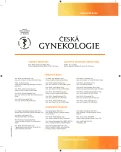-
Home page
- Journal archive
- Current issue
Czech Hospital in Uganda and quality of obstetric care
Authors: J. Donát 1; E. Brejchová 2
Authors‘ workplace: Porodnicko-gynekologická klinika, Pardubická krajská nemocnice, Pardubice, přednosta doc. MUDr. M. Košťál, CSc. 1; Gynekologicko-porodnická klinika FN, Plzeň, přednosta doc. MUDr. Z. Novotný, CSc. 2
Published in: Ceska Gynekol 2016; 81(2): 155-158
Overview
Objective:
The target was to evaluate the present state of obstetric care in Czech Hospital in Buikwe in Uganda. We evaluated a professional level of hospital physicians, their obstetric expertise and technical equipment of delivery theatre and mobile surgery and we provided a short 4 months evaluation of deliveries in main view of obstetric pathologies, frequency of caesarean sections and maternal mortality.Methods and results:
In period from October 2014 to January 2015 there was evaluated a group of 374 women, admited to labour at delivery theatre. We evaluated parity of women, number and indications of caesarean sections, age of women and obstetric finding by admission. The most of our patients were primiparas and secundiparas, the caesarean section was performed in 23,8% of cases and the most frequent indication of it was threatened rupture of the uterus, state after caesarean section, cephalopelvic disproportion and obstructed labour. Two women died. By evaluation of quality of obstetric care we have found some serious lacks. Ugandan doctors are not obstetricians, they have no experience with vaginal obstetric operations, the Hospital has no fetal-monitor and no possibility for a transport of emergency cases.Conclusions:
The Hospital needs expert help from Czech Republic, as doctors-obstetricians so as some equipment for delivery theatre and above all suitable car for urgent transport and for use of mobile surgery.Keywords:
Uganda, Czech Hospital, obstetric care, caesarean section, lacks, specialists, equipment, transport
Sources
1. Bulletin Arcidiecézní charity Praha. Česká nemocnice sv. Karla Lwangy. Výroční zpráva 2014.
2. David Tsu, V. New and underused technologies to reduce maternal mortality. Lancet, 2004, 363, p. 75–76.
3. Donát, J. Česko-slovenská nemocnice v Ugandě v letech 2009–2010. Čas Lék čes, 2011, 150, s. 174–177.
4. Donát, J. Český model na snížení mateřské úmrtnosti v Ugandě. Čas Lék čes, 2009, 148, s. 338–341.
5. Hogan, MC., Foreman, KJ., Naghavi, M., et al. Maternal mortality for 181 countries, 1980-2008: a systematic analysis of progress toward Millenium Development Goal 5. Lancet, 2010, 375, p. 1609–1623.
6. Maternal Mortality in 2000: Estimates development by WHO, UNICEFF and UNFPA, cit. Gwatkin, DR. Assessing inequalities in maternal mortality. Lancet, 2004, 363, p. 5.
7. Okong, P., Byamugisha, J., Mirembe, J., et al. Audit of severe maternal morbidity in Uganda-implications for quality of obstetric care. Acta Obst Gynec, 2006, 85, p. 797–804.
8. Weeks, A., Lavender, T., Nazziwa, E., Mirembe, F. Personal accounts of near-miss maternal mortalities in Kampala, Uganda. BJOG, 2005, 112, p. 1302–1307.
9. WHO systematic review of maternal mortality and morbidity: the prevalence of uterine rupture. BJOG, 2005, 112, p. 1221–1228.
Labels
Paediatric gynaecology Gynaecology and obstetrics Reproduction medicine
Article was published inCzech Gynaecology

2016 Issue 2-
All articles in this issue
- Czech Hospital in Uganda and quality of obstetric care
- Posterm pregnancy
- Induction of labor
- Current status and recommendations for intrapartum monitoring of fetal heart rate
- Delivery of macrosomic fetus
- Assisted vaginal delivery
- A recommended interdisciplinary guideline the diagnosis and treatment of sepsis during pregnancy
- Use of methotrexate in the ectopic pregnancy and pregnancy of unknown location
- Diagnosis of tuberous sclerosis complex focusing on prenatal period
- Czech Gynaecology
- Journal archive
- Current issue
- About the journal
Most read in this issue- Current status and recommendations for intrapartum monitoring of fetal heart rate
- Induction of labor
- Posterm pregnancy
- Delivery of macrosomic fetus
Login#ADS_BOTTOM_SCRIPTS#Forgotten passwordEnter the email address that you registered with. We will send you instructions on how to set a new password.
- Journal archive
